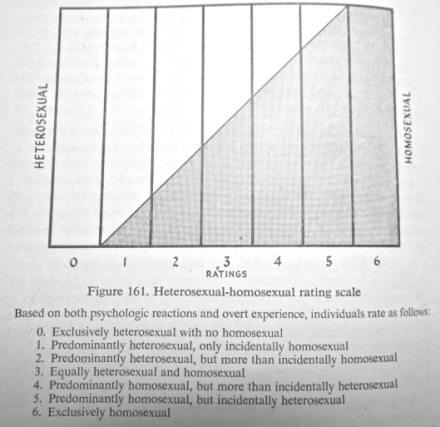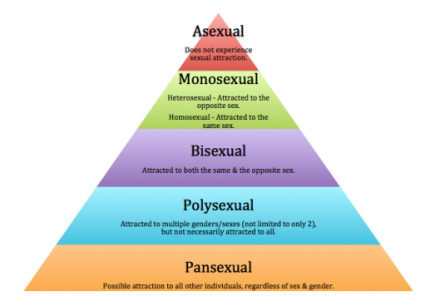To read Part One about biological sex, click here.
Gender
Gender is a social construct, created largely by stereotypes of what is “feminine” and what is “masculine.” In our society, being feminine is usually synonymous with being sensitive, caring, and demure. Traditional feminine appearance includes dresses, high heels, and make-up. Masculinity, on the other hand, is measured in strength, ambition, and confidence. Masculine physical appearance includes a muscular build, facial hair, and tuxedos. Of course, this is a very simplified description of the gender ideals that exist, but most of us become well aware of them from a very early age. We quickly absorb messages about what toys are acceptable (trucks for boys/dolls for girls) and how we’re supposed to act (being ladylike/manning up).
Contrary to what many people believe, a person’s gender does not depend on their physical sex. Rather, gender is how a person identifies and expresses themselves. It is only because we live in a society that has a strong gender binary that we automatically assume a person born with a penis will identify with mostly masculine traits, while a person born with a vagina will associate with mostly feminine traits. When this is the case, and sex and gender do match, a person can be described as being a cisgender male or a cisgender female. (In Latin, “cis” means “on this side of.”)
When a person identifies as the “opposite sex” that person can be described as a transgender, or trans, individual. (In Latin, “trans” means “on the other side of.”) We often hear the phrase “born in the wrong body,” as that is how strongly many individuals in the trans community feel about their gender identity. For example, a person with a penis could identify as female and be a trans woman, while a person with a vagina could identify as male and be a trans man. (It’s important to remember that “transitioning,” or deciding to live as the gender that one identifies with, is not a “one size fits all” process. Some change their name and wardrobe, others may take hormones and have surgery. This is an individual’s personal choice and despite what some TV talk show hosts would lead you to believe, what’s under someone’s clothes is no one’s business.)
For a lot of people, both cis and transgender identities are fairly easy to understand: You either feel like a man or you feel like a woman. But what if you feel like neither — or maybe both? Earlier this year, Facebook began to allow a much wider range of gender options (at least 58, to be precise). Many of them were terms that people were unfamiliar with, as they challenge the idea that an individual has to be male OR female.
Here is a small sample, highlighting some of the most basic terms used to describe non-binary options. (Remember that because gender is a societal construct, these distinctions are labels that we have created to describe how someone subjectively defines their experience with gender.)
Agender is used when someone has a complete lack of gender. Other terms may be “genderless” or “gender neutral.”
On the other hand, bigender individuals consider themselves both male and female. Their gender identity and/or expression may be fixed so that they experience both genders at the same time, or they may be gender fluid, where their gender changes or fluctuates over time. (Similarly, but more inclusive, pangender individuals identify as all genders, including the non-binary ones.)
Gender Nonconforming is a term that is used to describe someone who may primarily identify as one gender (man or woman) but does not abide by the stereotypical expressions for that gender. I would argue that many of us are gender nonconforming in some way as very few people follow societal stereotypes 100%. However, for a more clear-cut example, consider a self-identified woman with short hair and men’s clothing or a self-identified man wearing make-up. Because of society’s gender standards, these people would be seen as not conforming to their gender in fairly obvious ways.
When a person is unsure of their gender, they may decide to identify as gender questioning. During this time, a person may experiment with different ways to express their gender by altering their appearance and/or behavior — or they may simply be inwardly considering which gender feels most true to their personality.
Finally, genderqueer is an umbrella term that is used to describe anyone who challenges the man/woman gender binary. This term is growing in popularity, especially by the younger generation who wishes to reclaim the word “queer” and give it a positive connotation.
Sex & gender are commonly considered to be some of the most straightforward characteristics about a person. However, as you can see, society’s insistence that everyone is strictly “male” or “female” ignores the more nuanced way that many people define themselves. As potential doctors, teachers, co-workers, family members, friends, or romantic partners of individuals who do not fit into the gender binary, it’s important to recognize that sex & gender are not always as simple as we’ve been led to believe.
Education can be a powerful first step in creating change because it challenges false beliefs in a rather objective, logical, and emotionally-removed way. But what more can be done in our daily lives?
Stand up against discrimination or hate when you see it. Refuse to accept behavior that makes a “freak” out of someone, whether that behavior is quietly staring or publicly asking about someone’s genitals. Remain aware that a person’s preferred name may not match their legal name and their preferred pronoun may not match the pronoun you might automatically assign to them. Remember that it’s always okay to ask what a person prefers, and when that’s not possible, aim for gender neutral language. (Changing your language can sometimes be difficult, but I’ve learned that most people are very understanding as long as honest effort is being made.)
In the end, it all boils down to one little word: Respect.



